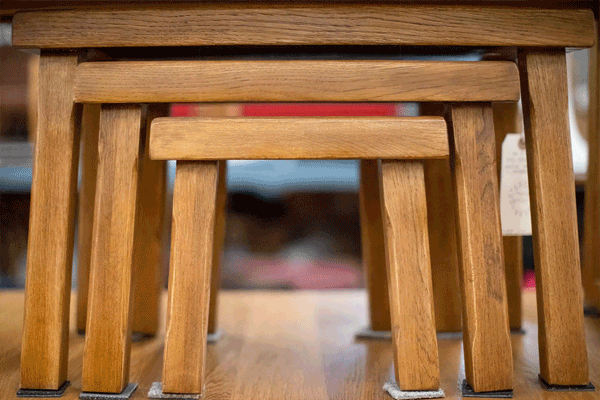New and Renewable Furniture From Old--and Odd--Sources
- Share via
NEW YORK — Americans consider recycled furniture to be pieces rescued from Grandma’s attic, picked up at garage sales or purchased as fine antiques.
Now there are other forms to ponder. New pieces are being made from old wood or from other materials that don’t rob nature or otherwise harm the environment.
This year, the first in the eight years that it has been in New York, the International Contemporary Furniture Fair mounted a display of about 25 such products.
“This is a new way of thinking that starts with the manufacturing process,” says Susan Szenasy, editor of Metropolis magazine, a co-sponsor of the trade show.
Although recycling is the main idea, other concepts come into play. There’s the use of readily available and renewable resources such as plywood instead of scarcer materials such as wood veneers and marble.
There’s the job of reformulating products to make them more benign and biodegradable.
Salvaged wood made an appearance at the show as an elegant credenza with serpentine front made of recycled wood flooring.
“I started with old flooring out of ecological convictions, but now I also prefer the look of it,” says Patrick Moore, who studied metalworking at the University of Wisconsin before moving to New York.
Moore says the raw material is easy to find, though pulling out the nails cuts into his creative time.
“It’s surprising what you can find on the streets,” he says, “loaded into dumpsters at construction sites or simply sitting out waiting to be collected in the garbage.”
At least 20 companies at the trade show chose plywood as a more acceptable resource than wood veneer. Birch plywood pieces by David Kawecki for 3D Interiors of San Francisco are designed to be assembled at home by fitting tabs into slots.
“It’s the design that makes the pieces interesting,” says Patrice Davis, owner of 3D Interiors.
“The tabs and slots require a high degree of accuracy in cutting, which is possible only with laser cutters. Five years ago this furniture couldn’t have been made.”
Wood paneling and natural stone facings are luxury materials and expensive to install. To reduce overall costs, Maya Romanoff Corp., a to-the-trade fabric and wallcoverings company in Chicago, introduced wallcoverings containing small quantities of wood or marble mixed with bonding agents and adhesives.
Wood-veneer wallpaper is made of sheets of Chinese fig or pauonia wood bonded to a backing. It comes in a variety of patterns, including diamonds and squares. Other Romanoff wallcoverings combine wood pulp with rayon fabric, and pulverized marble is bonded to look like blocks of stone.
But for true cutting-edge design, look to pieces by recent design school graduates. Isabelle Moore of Redmond, Wash., created a sleek rocking chair from recycled detergent bottles and plywood at Parnham College in Dorset, England. The primary material, a high-density polyethylene, is known in the plastics trade as confetti because of the colors derived from a variety of bottles.
*
Inna Alesina collected egg cartons from New York City restaurants as the primary material for a stool she designed and made before graduating this spring from Parsons School of Design. The stool looks a bit like a giant Cheerio when not in use, more like an egg when sat upon.
Alesina’s tool was a prototype made as part of a design contest. Moore’s rocking chair, $990 and made by hand in her studio, is expensive considering it is made of recycled material.
But the material is expensive to buy at the moment, and there is a substantial amount of hand labor, Moore says.
Both pieces will be on show at the Washington State Convention Center in Seattle through Sept. 26 in an exhibition of award-winning, environmentally sound designs. The contest, in its second year, is sponsored by the Clean Washington Center and other groups and administered by Johnson Design Studio of Seattle.
“Right now, environmental design is cutting edge,” Szenasy says. “But there is grass-roots sentiment for it, especially among kids who are growing up recycling their soda bottles and hearing about the environment from characters like Kermit the Frog.”


